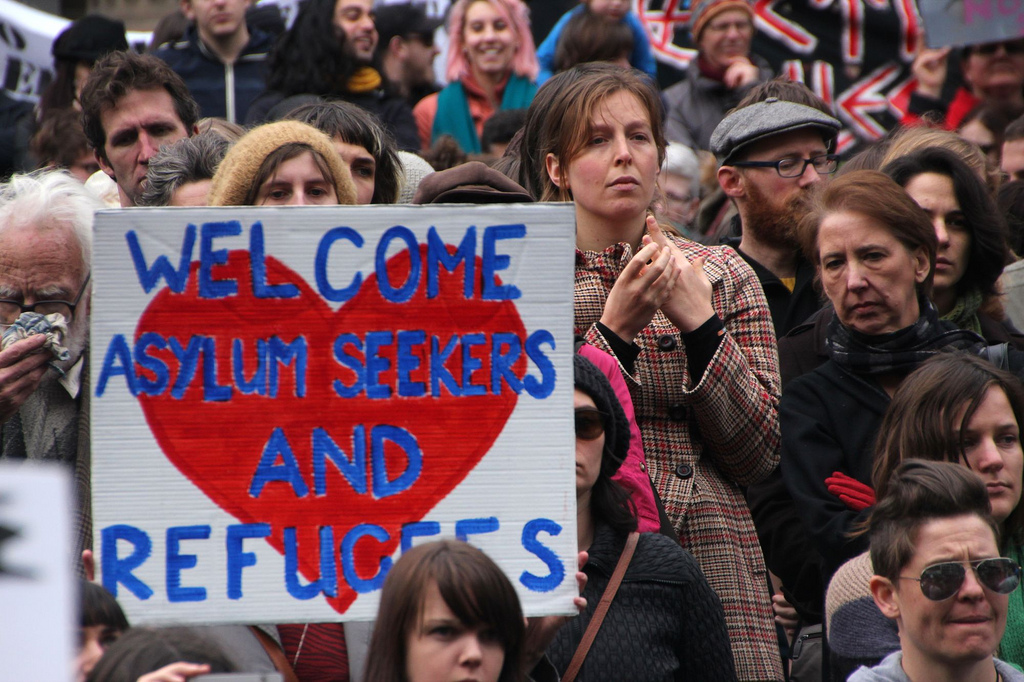Asylum Seekers Are Not Jumping Ahead in The Refugee Line
Immigration Lawyers in Canada Discuss the Myths and Challenges of Asylum Seekers Who Have Crossed Illegally
The growing number of asylum seekers entering Canada from the U.S. at unofficial borders is causing concern amongst Canadians and the government. Many Canadians are concerned about the health and safety of the asylum seekers, especially those braving the frigid winter weather while crossing into Manitoba. Government officials and immigration lawyers in Canada are debating the implications of the Safe Third County Agreement and how to prevent more illegal border crossings.
Another question that has come up is whether these asylum seekers are jumping ahead in the refugee claims process, possibly decreasing the chances for other refugees across the world to immigrate to Canada. To clarify the Canadian immigration process for those who want to file a refugee claim, an immigration lawyer in Canada can help.
According to a recent CTV News article, there is a debate over whether or not asylum seekers are “queue jumping” the refugee claims process in Canada. Although one immigration lawyer in Canada says the government will have to put a limit on the number of refugees it accepts, another lawyer dispels the myth of asylum seekers “queue jumping.”
Currently, Canada has two refugee systems in place—one for those on Canadian soil and one for those in other countries, especially refugee camps. These two systems are not affected by each other, therefore, the number of refugees accepted on Canadian soil will not prevent refugees overseas from having a chance to immigrate to Canada.
No matter where the refugee claims are being made, asylum seekers must prove that they are at risk of persecution in their home countries. This brings up additional challenges for those entering Canada from the U.S. A Canadian immigration lawyer spoke to CBC News about the further difficulties faced by asylum seekers fleeing the U.S. Many of these asylum seekers are leaving the U.S. for fear of deportation because their refugee claims have been denied. Others may have refugee status in the U.S., but fear their future with Trump’s immigration policies in the U.S.
For those whose refugee claims have been denied in the U.S., they may lack supporting documentation for their claims. If they do not meet the Canada-USA Third Safe Country Agreement (‘Agreement’) exceptions, then they will not be able to make a refugee claim in Canada. For those who meet one of the exceptions to this Agreement, if they do not have the necessary evidential support for their claims or if their claim is found not to be credible, then they may be denied refugee status in Canada.
Asylum seekers who cross into Canada at unofficial borders do not have a better chance at gaining refugee status than those who cross legally or apply from overseas. In fact, those fleeing the U.S. may have a harder time proving their claims, because their subjective fear will be in question for having remained in the United States for a lengthy period of time without any legal status and for having failed to make a claim for protection in that country.
Immigration in Canada Is Key to Economic Growth and Stability
Canada Relies on Immigration to Boost Population Growth and Productivity in The Workforce
Canada’s open immigration policies are saving the country from a decline in both population and economic growth. Since the large generation of Baby Boomers continues to retire and fertility rates are on the decline, the working-age population will keep shrinking.
However, Canada continues to welcome immigration, including skilled immigrants, which has significantly helped with our population growth. Without immigration in Canada, we wouldn’t have enough workers participating in the workforce, being productive, and contributing to our economic growth and stability.
According to a recent Global News article, findings from Goldman Sachs economists suggest both Canada and the U.S. rely heavily on immigration for economic growth, and any reduction in immigration numbers will directly affect these countries’ economies.
Currently, the U.S. is ranked at the top of the G10 countries for population growth, with immigration contributing to almost half of the population growth. Canada is third, with immigration contributing to more than two-thirds of the population growth. Without immigration, these populations would drastically decline since populations are aging and fertility rates are dropping, especially in Canada.
Canada’s population growth has hit a plateau, which has been mirrored around the globe. Statistics Canada predicts that without immigration, Canada will see a zero percent population growth in 20 years. This is in large part due to our aging population and decline in fertility rates. But since many of the immigrants to Canada are younger than the average Canadian, the working-age population will continue to grow with the immigration numbers. Even though Canadians are having less children and more are retiring, immigrants are coming to Canada with their young families, contributing to the workforce, and keeping Canada’s economy on track.
Without immigration, Canada’s workforce would decline and the economy would slow down. We wouldn’t have enough workers to fill the many positions required to keep our country’s economy stable. But Canadians don’t have to worry about this, since immigration in Canada is encouraged and accepted.
The U.S., on the other hand, has much to worry about with Donald Trump’s new immigration policies. Not only can the U.S. population growth be stalled, and eventually decline with their aging population, but the U.S. can also lose many workers who contribute to a large part of the U.S. workforce. In addition, US policies may deter many professionals and intellectuals from choosing the United States as a country to pursue opportunities and higher education out of fear that they may be rejected or mistreated due to their race and nationality.
More Asylum Seekers Risk Their Lives to Get Into Canada
An Immigration Lawyer in Canada Can Help Asylum Seekers Avoid the Dangerous Trek into Canada
The contrasting immigration policies of Canada and the U.S. are causing more people to seek refuge in Canada for fear of deportation by the U.S. government. The number of asylum seekers entering Canada via illegal border crossings has significantly increased in the past year, and especially since Donald Trump was elected and imposed his immigration ban. These people are risking their lives in the freezing temperatures to cross into Canada. For those seeking refugee status, an immigration lawyer in Canada can help with the application process.
An article from ABC News describes the harrowing journey some asylum seekers make for a second chance at safety, freedom, and life. This past Christmas Eve, two asylum-seekers trekked through fields of waist-high snow in freezing temperatures to reach Manitoba. Their 10-hour-long trek from the U.S. cost these men all of their fingers and almost cost them their lives. Since it was Christmas Eve, there were no cars on the road to help them. After seven hours of hoping for a car to pass, a truck finally stopped and brought them to safety.
These men suffered from serious frost bite and were certain they were going to die from the cold. Although they’ve lost their fingers, they are still grateful to be in Canada. Had they stayed in the U.S., they would have been deported to their home country. These men were at risk of imprisonment and execution; one of the men risked persecution for his sexual orientation.
These stories are becoming more familiar as more asylum-seekers, including families with children, are entering into Canada at illegal border crossings. These people are risking their lives to find a safer home in Canada.
The increase in asylum-seekers has been attributed to Trump’s anti-immigration stance. This stance has immigrants fearing deportation if their asylum claims are denied in the U.S. These asylum-seekers are also making the dangerous trek illegally into Canada because of Canada’s Safe Third Country agreement with the U.S.
Under the Agreement, refugee claimants must request refugee protection in the first safe country they arrive in, unless they qualify for an exception to the Agreement (family member exceptions; unaccompanied minor exceptions; document holder exceptions; public interest exceptions). Canada and the United States signed the Agreement on December 5, 2002. It came into effect on December 29, 2004.
Currently, Canada's Immigration and Refugee Protection Act designates the U.S. as a safe third country. It is the only country with such a designation under the act.
The two men who lost fingers while crossing into Manitoba say that Canada has been more welcoming than the U.S. They added that Canadians treat them with respect and give them a fair process. Given the present political realities in the United States, Canadian officials and decision-makers should take steps to abolish the Canada-US Safe Third Country agreement in order to avoid putting the lives of those fleeing persecution at risk.
Tech Industry Immigration in Canada
Silicon Valley North Tech Industry Welcomes Skilled Workers Affected by Trump’s Immigration Ban
Donald Trump’s recent immigration ban has many skilled workers in the tech industry looking at more welcoming countries, like Canada, to call home. Although the ban has been overruled by the U.S. appeal court, there are still many tech workers doubting whether they can return to work in the U.S. The immigration ban also poses a major threat to U.S. tech companies whose workforce relies on skilled workers from around the world.
The Trump ban has also impacted Canadian dual citizens who were denied entry to the United States. Canada’s open immigration policies and booming tech industry, however, are welcoming those affected by the ban, with tech companies looking into options for a fast-track temporary residency for these workers.
Canadian tech companies have been competing with Silicon Valley for skilled tech workers for some time, leaving the Canadian tech industry in a bind to find enough highly-skilled workers to meet growing employment demands. In fact, it’s been reported that Canada’s tech sector (dubbed “Silicon Valley North”) will have a high-tech talent deficit of 200,000 by 2020. The amount of Canadians graduating in the technology field each year is not enough to meet the demands of the ever-growing tech industry.
To fulfill the high demand for skilled workers in the tech industry, Canadian tech companies are reaching out to workers who may be affected by Trump’s travel ban. An open letter to Canadian Prime Minister Justin Trudeau was signed by 2,000 of Canada’s top tech industry workers, urging Canada’s immigration department to immediately grant temporary visas to tech workers affected by Trump’s immigration ban.
Temporary residency permits allow individuals to live and work in Canada while awaiting decisions on permanent residency applications. With Canada’s welcoming immigration policies and tech industry, more global tech companies are also looking at Canada as a viable option for relocation. In fact, some of Canada’s immigration law specialists have received inquiries from tech start-ups and global companies interested to open offices in Canada.
Canada’s global reputation for being a diverse, welcoming country for all nationalities will attract more skilled workers from around the world, including high tech workers. Many of the individuals who were affected by Trump’s immigration ban still remain uncertain about their future ability to travel, study, or work in the U.S. As such, they are likely to avoid future travels to the United States in order to avoid potential mistreatment and denial of entry at the border.
In a global economy, where diversity and multiculturalism is an asset, Canada has an opportunity to reinforce these values while also gaining a competitive edge economically.
Judicial Reviews Before the Federal Court
A Look at The Judicial Review Process and How Immigration Lawyers in Canada Can Help
If you have received a negative decision on your immigration, refugee, or citizenship matter, a Canadian immigration lawyer can help. An immigration lawyer will guide you through the application process for a judicial review to examine the reasons for the negative decision. In turn, this could potentially overturn the decision, and send the matter back for a re-determination.
The judicial review application process has two stages: the judicial review leave application and the judicial review hearing. The application will only proceed to a hearing if the leave application has been granted by a judge of the Federal Court, based on whether the Applicant has presented an arguable case.
Review of Negative Decision
The first step in the judicial review process is to provide your lawyer with all pertinent information and documents regarding your negative decision. Be sure to include your notification of the negative decision from immigration officials.
Your immigration lawyer will review the reasons for the negative decision and determine if the decision can be challenged as being unreasonable, incorrect, or procedurally unfair. The decision maker may have also failed to take into account the rights and values enshrined in the Canadian Charter of Rights and Freedoms in rendering a decision.
Some of the main reasons for allowing an application for judicial review include whether:
(a) The decision-maker made an error in law;
(b) The decision-maker misapprehended the facts, or appears to have ignored a fact of fundamental importance;
(c) The decision-maker violated a principle of natural justice, or failed to observe procedural fairness;
(d) The decision-maker’s decision goes beyond the authority conferred upon the decision-maker by the Immigration and Refugee Protection Act and the Immigration and Refugee Protection Regulations.
Timelines for Judicial Review Leave Applications
According to section 72 of the Immigration and Refugee Protection Act, anyone seeking the judicial review of a decision, determination, order made, a measure taken, or a question raised must first seek leave of the Court. For the purposes of calculating the time limit within which the application for leave and judicial review must be commenced, an officer’s decision in a matter arising in Canada must be commenced within 15 days after the date on which the person concerned is notified of, or otherwise becomes aware of, the matter.
However, the review of an officer’s decision in a matter arising outside Canada must be commenced within 60 days after the date on which the person concerned is notified of or otherwise becomes aware of the matter. According to the Regulations in the absence of proof to the contrary, a person is deemed to be notified of a decision seven days after the day on which notice of the decision was sent to the person, unless the decision was made in their presence.
Once reviewed, if there is an arguable case, your Canada immigration lawyer will advise you on the chances of success at the hearing. If you decide to proceed, your lawyer will prepare your application record, including your affidavit together with exhibits and a Memorandum of Argument.
Once the judge reviews the Application Record and is satisfied that the Applicant has raised a serious or arguable issue, leave for judicial review of the decision will be granted. If leave is granted, the hearing must be held not earlier than 30 days and not later than 90 days of the date granting leave.
Additional Requirements for Filing a Leave Application
Your leave application must:
- Include the specific relief you are seeking for judicial review, if you are granted leave;
- Indicate if you have not received the reasons for your negative decision in writing, so the reasons can be sent to you, to the Court, and to the Respondent;
- Include a fee payment of $50 at the time of filing your leave application—payment can be made via Visa, MasterCard, or American Express credit card, cash, debit, or a personal cheque or money order made out to The Receiver General of Canada;
- Include copies of your leave application certified by the Registry; upon certification, the Registry will return the copies to you (to be served to respondents) and keep the original leave application.
Application for Judicial Review
The hearing will determine the outcome of the application for judicial review. At the hearing, your immigration lawyer will present your case with strong arguments to persuade the court. If your lawyer successfully argues your case, your negative decision can be set aside and your immigration matter will be returned to immigration officials for reconsideration.
Although it may seem like a difficult and stressful process, your immigration lawyer will find every arguable detail in your case, file documents, and present your case in court on your behalf, so you will have the best chance to appeal your negative immigration decision.





